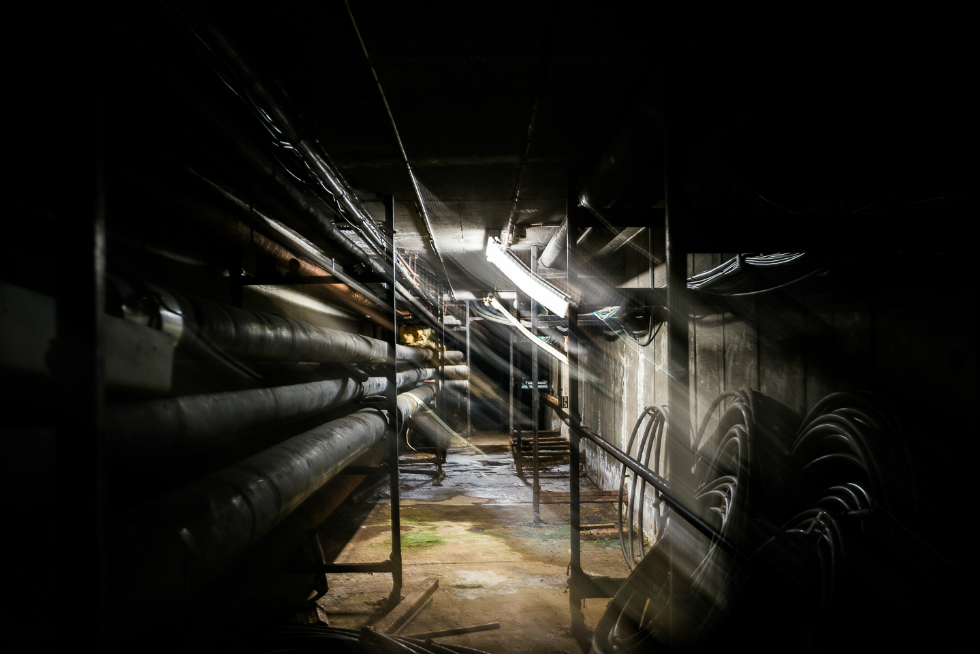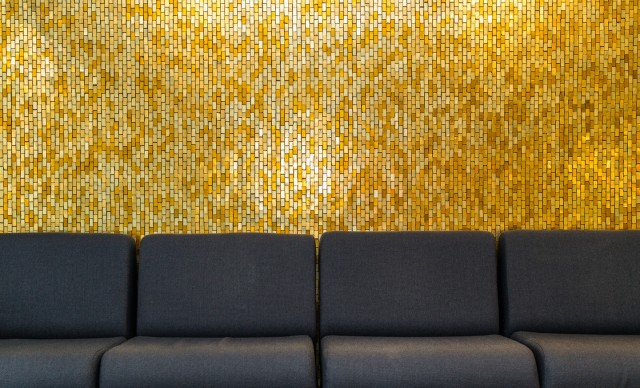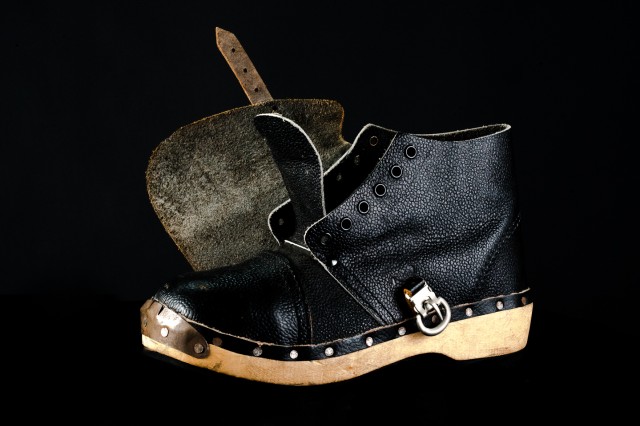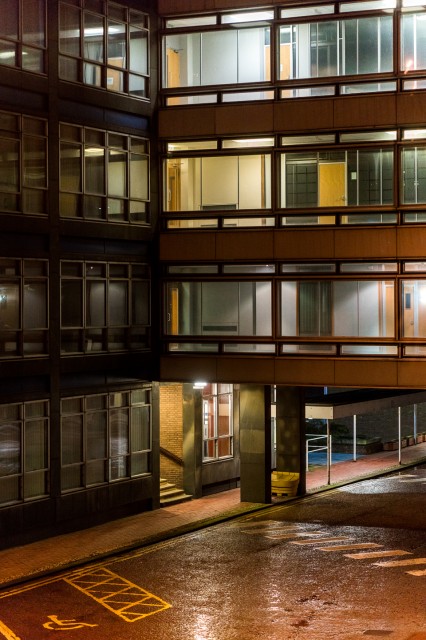“The mundane becomes uncanny”: Kevin Casey’s View Of A Night Watchman

What must it feel like to be a security guard on patrol, alone? Pacing silent factory floors in the dead of night? In this excerpt taken from his new book of photography, and ahead of Friday’s exhibition opening, Laura Robertson introduces artist Kevin Casey’s Shouldn’t Throw Stones – The View of a Night Watchman…
To imagine a night watchman doing his rounds is to imagine an individual who is familiar with being alone. Time seems to slow down, maybe even stop. He patrols pitch black corridors, torch in hand. Sturdy shoes make muffled thumps, keys jangling with each step. You fancy that his weak torch beam reaches thinly across huge, empty rooms. He startles himself with the flash – suddenly seeing his reflection in a window. Every sound made on his route is amplified by offices and workshops devoid of people: echoes bounce, bounce, bounce, reaching ahead of him. He dreads the distant tinkle of glass, or the laughter of bored, trespassing teenagers.
This is a rather romanticised idea of what Kevin Casey has been doing between the hours of 6.30pm and 6.30am for the past several months. The British artist and photographer is, at time of press, moonlighting as a security guard at Alexandra Business Park, St Helens[1]; paid to protect a tired-looking, Grade-II listed set of buildings nestled in greenfield, boxed in by busy roads. He is paying the bills whilst taking advantage of the access the job allows, seeing it as an opportunity to record a post-industrial site which has a compelling past and an uncertain future. Casey will not be a night watchman forever, nor will this place remain frozen in time.

Alexandra Business Park is a place of historic interest[2]. Originally designed and built during 1959-63 as the Pilkingtons Glass Headquarters, Pilks – as it is known locally – now belongs to a property developer. Some of the concrete-framed buildings are used during the day by a variety of businesses, including NHS administrators. Some spaces are not in use at all. When Casey is there, the site is overwhelmingly silent and dark; his route takes him into corners vacant for ten years or more. He circles the lake (fountain switched off) and crosses the concrete bridge. He makes his way into the car park, past the gatehouse, into the reception (bank of CCTV). Two corridors of occupied offices lead through to the old main reception (dominated by a golden, stained-glass relief) and the vacant canteen block. He treks up to abandoned executive suites, telecoms rooms and down to factory floors.
Casey finds artefacts: curling manuals extoling the rules and virtues of glass manufacture; dog-eared photography (of the newly built showrooms, of the women’s hockey team) discarded on the floor. Clues allude to the dangers of the job: one of his prized finds is a pair of leather-bound wooden clogs, made to protect feet from huge sheets of glass. He has even found a surgeon’s bag and osteopath’s model skeleton from the on-site operating theatre, a department used with frightening frequency to sew limbs back on[3]. Here, slips and falls could be life-altering, sometimes deadly.

Not so now. As the day workers cease typing and photocopying and boiling kettles, a skeleton crew of cleaners and security guards move in. They are like ghosts; doing unseen, unappealing work, and disappearing before the first office staff return at 8.30am. They are unnoticed by most, it seems, apart from colleague Casey. He records their presence just as he catalogues the building’s sorry state and former glories. He sees his sparsely occupied surroundings as subject matter; each shot produces a layer of dates and people and objects, one era atop another.
Arguably, Casey uses his camera to break out of a linear timeframe, as the photographs in this book are as much rooted in the 1900s as the 2000s, and chart in their own way the demise of British industry. From the latter half of the 1940s until the 1970s, plentiful jobs could be found in St Helens in coal pits or at glass factories like Pilkingtons, UGB or Forsters[4]. Pilks hired generations of the same family. The company was central to the local economy and culture of St Helens, even running its own club nights and travel agency[5].

Despite its current dilapidated appearance, the former-HQ simmers with social importance. It is a physical feeling; a tense atmosphere made by the absence of many people once present. Casey has succeeded in capturing this strange state, of people being there and not there all at the same time. During one site visit, we toured the 12th floor executive suite with several former workers. As the light faded, we had an unrivalled view of St Helens and the fields and woodland beyond. Casey left a tripod behind, and I went back alone to fetch it. Thick carpet and pine-panelled walls soundproofed the entire department. It was my only – very brief – experience of walking in Casey’s shoes. Despite trying to tell myself the contrary, I was thoroughly spooked.
This sense of unease lingers throughout the images. Time blurs. In one shot, an internal courtyard is surrounded by dirty puddles, glass smashed and climbing flora reaching for the light; in another, a clocking-in machine is frozen at five-past four, chad from punched cards scattered around it; in another, a young man poses in a crisp white shirt and lanyard, furtively looking to one side with bruised eyes – the result of a scuffle with intruders, or from a night out in town, we don’t know. The photographs emit a decaying light, telling of Casey’s peculiar hours. Thus illuminated, the mundane becomes uncanny.
Laura Robertson
See Shouldn’t Throw Stones – The View of a Night Watchman at Alexandra Business Park, St Helens, from Friday 4 May until Sunday 3 June 2018. Exhibition and tour tickets must be reserved; click here to book yours for FREE
Buy the accompanying book! With an introduction and in conversation by Laura Robertson, and a foreword by artist/curator Elizabeth Wewiora, priced £14.99, ISBN 9781789260823
Shouldn’t Throw Stones is the culmination of a two year project undertaken by artist Kevin Casey, funded by Arts Council England with support from Liverpool John Moores University, Alexandra Business Park and G. F. Smith
[1] Alexandra Park (St Helens) Management Limited, Prescot Rd, Saint Helens WA10 3TP
[2] The Former Pilkingtons Headquarters complex is listed under the Planning (Listed Buildings and Conservation Areas) Act 1990 as amended for its special architectural or historic interest. List entry Number 1259806, Historic England online archive
[3] From my recorded interview with a former Pilks worker, May 2017, in which the interviewee recounted her father’s experiences of working on the factory floor as a young man in the early 20th century
[4] Alan Whalley, 1997, Heyday of the Brown Bomber, The Bolton News online news article
[5] From my recorded interview with a former Pilks worker, May 2017, in which the interviewee recounted her experiences of company culture





